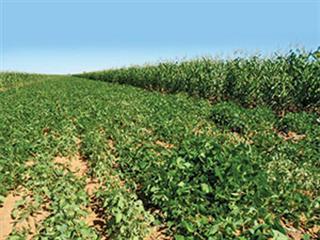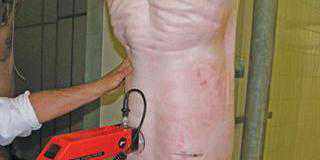
Argentina’s crop farmers are renowned for their efficient grain production, and it’s no secret that their success is due largely to their mastery of direct planting (no-till in stubble) farming systems. Indeed, the country has become a world leader in the techniques involved and the adaptation of machinery for direct planting. Believing that South Africa could benefit from adopting some of the Argentinian farming systems and practices, Grain SA and several Argentinian agricultural organisations launched a five-year trial in 2011 aimed at comparing Argentinian direct planting methods with South African conventional (tilled) practice.
The trials include:
- Adapting Argentinian practices to South African conditions.
- Investigating plant population, cultivar requirements and row spacing.
- Determining the optimal crop rotation programme and its effects.
- Evaluating current weed control programmes and their long-term results.
- Evaluating Argentinian implements under South African conditions.
- Determining the effect of the change – from conventional SA tillage to Argentinian direct planting – on soil fertility and adapting the fertilisation norms for the systems.
- Evaluating the technology’s economic feasibility.
- Publishing the information for farmers.
Four official trials have been planned in four regions in South Africa. Each represents a specific agro-ecological type:
- Nigel – cooler eastern production region.
- Lichtenburg – warmer western production region.
- Odendaalsrus – water table soils.
- Settlers – Springbok Flats and heavy clay soil types.
The Odendaalsrus trial could not be planted, as heavy, continuous rain in December 2011 and January 2012 resulted in waterlogged soil. However, other trials were planted at:
- Wonderfontein near Middelburg in Mpumalanga – to evaluate the system in the cooler climate of the eastern Highveld.
- Ottosdal – warmer western production region.
- ARC GCI in Potchefstroom.
Outline of method
A trial occupies a plot of about 10ha and comprises two sections: a conventional tillage trial section representing the farmer’s existing practice, and Argentinian-style direct planting. Rotation is also evaluated and maize is rotated with sunflower, soya bean and permanent pasture. On sandy water table soils, wheat is included in the rotation.

In the Argentinian practices plot, a single-ear, single-stemmed maize cultivar was planted in 52cm rows at various planting rates. Inter-row spacing of 90cm, 150cm and 240cm were also on the trial sites for comparison. Different maturation period soya bean cultivars were planted in 52cm and 90cm rows at two plant populations. The maize plant population in the Argentinian practices sections varied from 37 000/ha to 80 000/ ha. The same fertiliser and herbicide programme was applied to all sites.
Better results from direct planting
From the start, many differences between conventional tillage and direct planting were obvious. Whereas conventional tillage churns up the soil, the Argentinian turbo coulters merely disturb the soil sufficiently to plant the seed at the correct depth and ensure enough loose soil for good root development. The stubble stays undisturbed on the surface.
What was particularly striking, however, was the smoothness and uniformity of the soil after the Argentinian planter had passed, and how uniformly the plants emerged. Spacing too was particularly even. In most trials, 97% of the direct-planted maize had emerged by day eight, while with the conventional system it took 11 days for 95% of the plants to emerge.
The high plant populations at the narrower row spacings produced enough shade to ensure that late-germinating weeds did not survive. In the cultivated sections, by contrast, more weeds emerged even though herbicide had been applied. In Nigel, there were also differences in growth rate between the various plant populations. Plants flowered sooner on the lands with lower populations.
Root development
Distinct differences in root development could be seen between plants grown with the two techniques. The conventional system’s root distribution was generally deeper than that in the direct planting system, whereas the latter showed a noticeably higher concentration of roots in the upper, fertile layer of the soil. The water table soil trial site at Bultfontein yielded an interesting observation. The trial was planted on a block where no chemical correction had been done and the soil compaction layers had not been broken up.
It was an exceptionally dry year, with the result that the roots did not penetrate the compaction layers at all. On the previous year’s ripper rows, however, the roots utilised the old crop’s decomposed roots as their channels to reach the water in the subsoil. Another significant observation was made at a farm in the Bultfontein district. The farmer had deep-tilled the land before planting dryland wheat. After harvesting, maize was direct-planted immediately.
The maize roots grew into the old wheat root channels and progressed into the subsoil water table. No difference in yield between the cultivated and directly planted sections was observed. The differences in plant populations also produced clear variations in soil moisture content and air temperature at ground level. Although the moisture studies have not been completed, more moisture was found in the topsoil at higher plant populations than at lower plant populations, due to the overshadow effect. In addition, and not surprisingly, it was found that the higher the plant population, the lower the temperature measured at ground level.
Good results in a bad year
The first year’s trials surprised everyone involved and clearly demonstrated the success of the direct planting system. The maize yields of 10t/ha without cultivation were remarkable, considering the extremely dry weather. Whether these results can be sustained is unknown at this stage but they certainly demonstrate that the Argentinian direct planting system holds promise for South African agriculture.
The direct planting system also showed cultivar differences. Not all cultivars performed equally well under direct planting conditions and some will definitely not be suitable. More evaluation is needed before optimal cultivars for the system are identified. One of the findings was that the tractor has to be well matched with the planter: a tractor that is too heavy was shown to cause excessive soil compaction – the rows planted on the wheel tracks did not grow properly.
In planting the trial at the ARC GCI, a lightweight tractor with just sufficient power to pull the planter was used. Very little wheel damage was observed, whereas major wheel damage was seen at the other trial sites. It should be remembered, though, that tyre pressure as well as the absolute size of the tractor is at play here. The higher the footprint pressure (kg/cm²), the greater the damage. Thus, a relatively light tractor with narrow tyres may have a higher footprint pressure than a larger tractor with very wide ‘flotation’ tyres.
Know your equipment
A farmer using the direct planting technique should begin by using a tine implement as early as possible – employing a shallow working action – so that the soil can stabilise before planting starts. This will expedite the planting process and help to ensure that the seeds are spaced uniformly. The turbo coulter should be set up accurately to cut through the first few compact layers so that the roots can penetrate the soil.
The taproots of sunflower and soya bean crops, for example, readily turn and grow horizontally under unfavourable conditions. A number of farmers’ days are being planned to enable farmers to visit the direct planting trials and study the implements being used at first hand.
Contact Pietman Botha on 082 759 2991.












